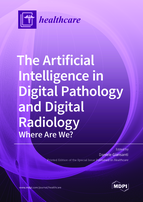The Artificial Intelligence in Digital Pathology and Digital Radiology: Where Are We?
A special issue of Healthcare (ISSN 2227-9032). This special issue belongs to the section "Artificial Intelligence in Medicine".
Deadline for manuscript submissions: closed (15 February 2022) | Viewed by 39541
Special Issue Editor
Interests: biomedical engineering; robotics; artificial intelligence; digital health; rehabilitation; smart technology; cybersecurity; mental health; animal-assisted therapy; social robotics; acceptance; diagnostic pathology and radiology; medical imaging; patient safety; healthcare quality; health assessment; chronic disease
Special Issues, Collections and Topics in MDPI journals
Special Issue Information
Dear Colleagues,
As a result of the incredible advances brought about by Information and Communication Technology (ICT) as seen today in electronic-health (e-health) and mobile-health (m-health), many new applications of both organ and cellular diagnostics are now possible. In the era of digitalization, we can speak specifically about the prospects of digital radiology and digital pathology.
Digital radiology includes the use of diagnostic imaging tools for organs based on systems compatible with Digital Imaging and Communications in Medicine (DICOM), known as DICOM-compliant. This includes not only instruments whose image formation processes are based on fields of interaction that use ionizing radiations, but also instruments based on ultrasound (ultrasound) and magnetic fields (nuclear magnetic resonance), for example.
Digital pathology, on the other hand, includes the use of digital processes related to instrumentation for cell diagnostics, which mainly takes two forms: histological and cytological. In this case, we speak of digital histology and digital cytology. However, other processes for digitizing information in the biomedical laboratory are also included in this area, such as those relating to the integration of cytometric reports.
Artificial intelligence (AI) is extending into the world of both digital radiology and digital-pathology and involves many scholars in the fields of technology and bioethics. These scholars are interested in both the potential applications of AI in feature recognition, diagnostics, automatic recognition, and quality control, and the limits and related problems. I invite you to contribute to this Special Issue, which has a broad scope. The following topics, though not exhaustive, will be considered: innovations in the field, including those correlated to the COVID-19 pandemic; the acceptance of AI in relation to all the actors involved, from the healthcare professionals to the patients.
This Special Issue of Healthcare welcomes commentaries, original research, short reports, and reviews on the challenges faced by health systems in this field.
Dr. Daniele Giansanti
Guest Editor
Manuscript Submission Information
Manuscripts should be submitted online at www.mdpi.com by registering and logging in to this website. Once you are registered, click here to go to the submission form. Manuscripts can be submitted until the deadline. All submissions that pass pre-check are peer-reviewed. Accepted papers will be published continuously in the journal (as soon as accepted) and will be listed together on the special issue website. Research articles, review articles as well as short communications are invited. For planned papers, a title and short abstract (about 100 words) can be sent to the Editorial Office for announcement on this website.
Submitted manuscripts should not have been published previously, nor be under consideration for publication elsewhere (except conference proceedings papers). All manuscripts are thoroughly refereed through a single-blind peer-review process. A guide for authors and other relevant information for submission of manuscripts is available on the Instructions for Authors page. Healthcare is an international peer-reviewed open access semimonthly journal published by MDPI.
Please visit the Instructions for Authors page before submitting a manuscript. The Article Processing Charge (APC) for publication in this open access journal is 2700 CHF (Swiss Francs). Submitted papers should be well formatted and use good English. Authors may use MDPI's English editing service prior to publication or during author revisions.
Keywords
- e-health
- Medical devices
- m-health
- Digital-radiology
- Digital-pathology
- Picture Archive and Communication System
- Artificial-intelligence
- Electronic surveys







